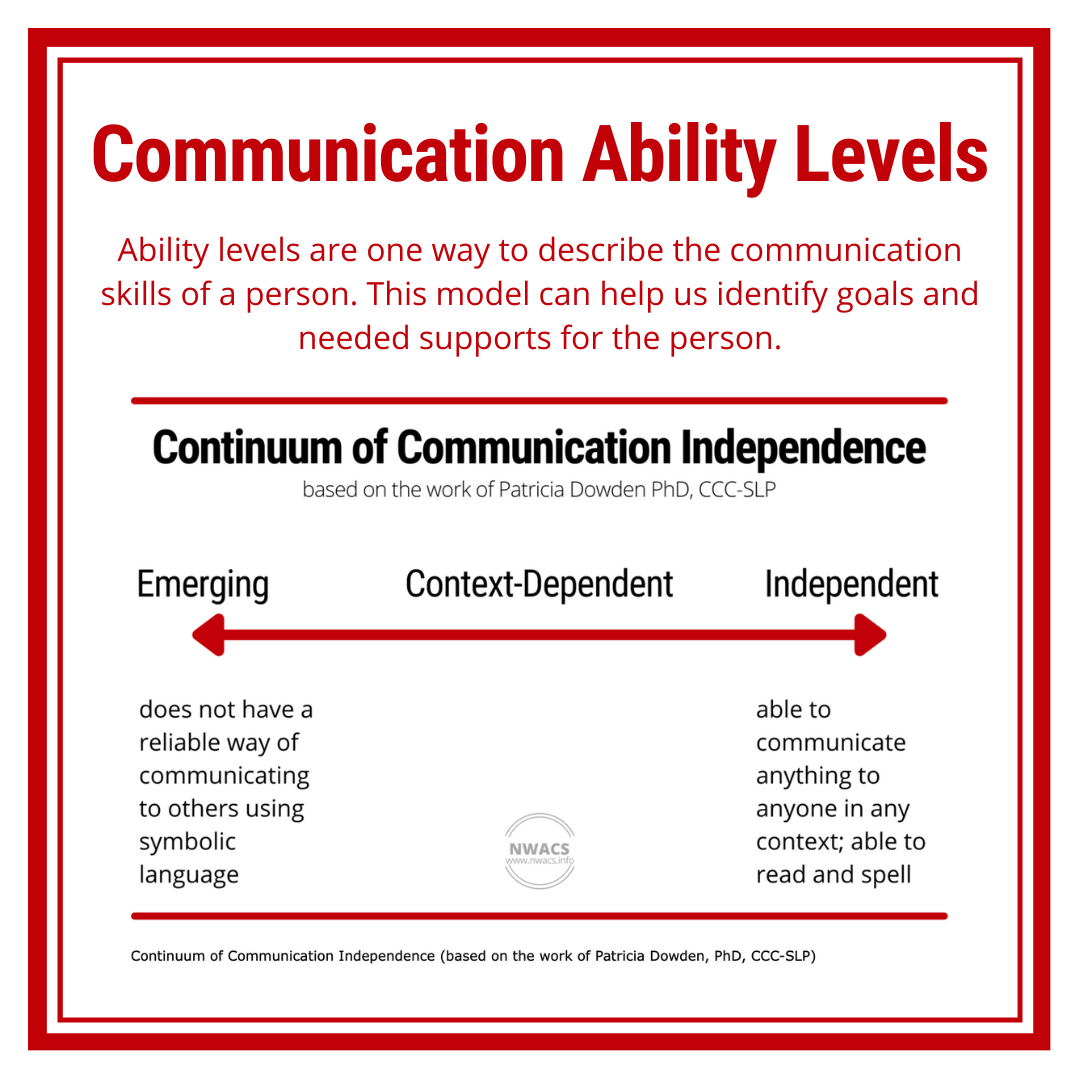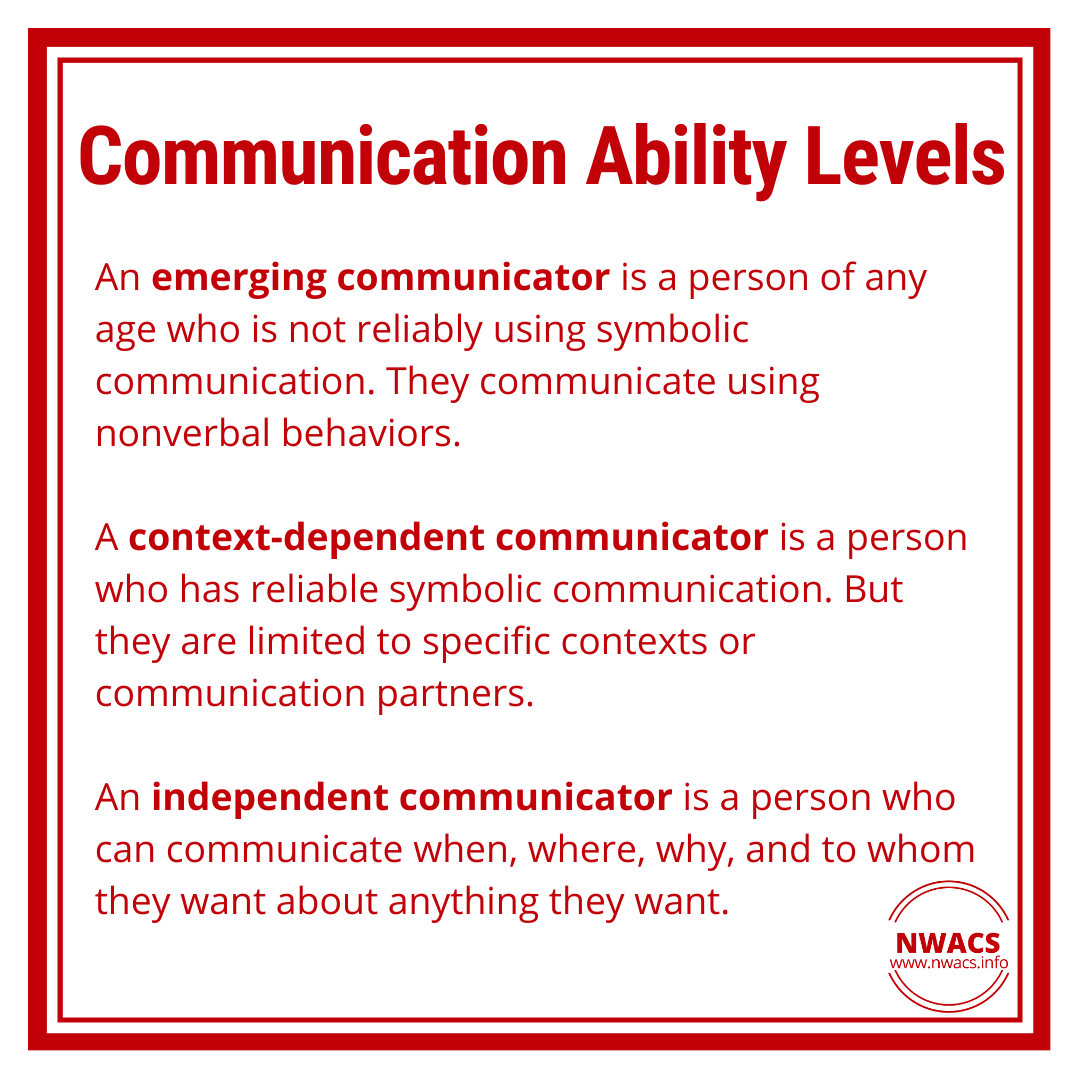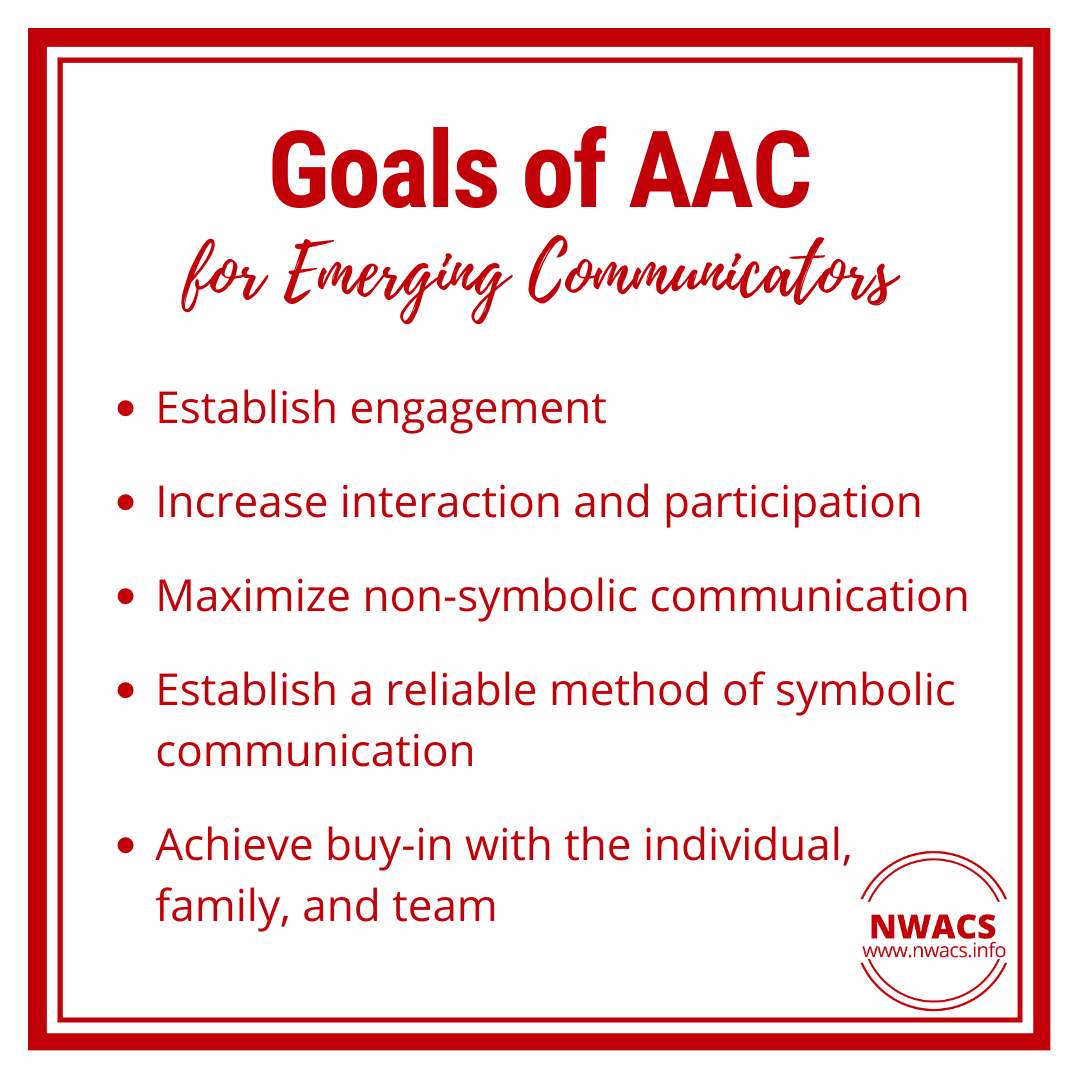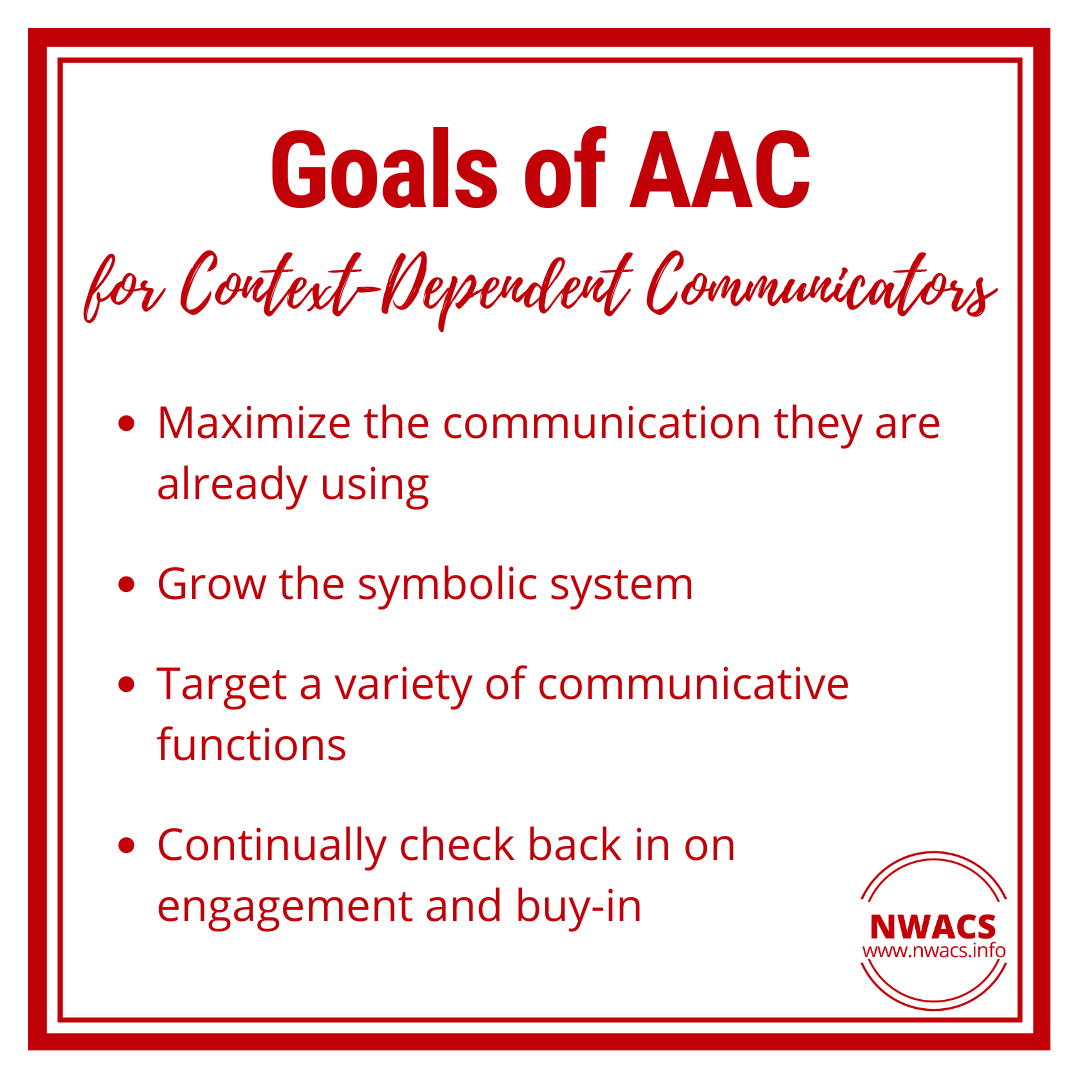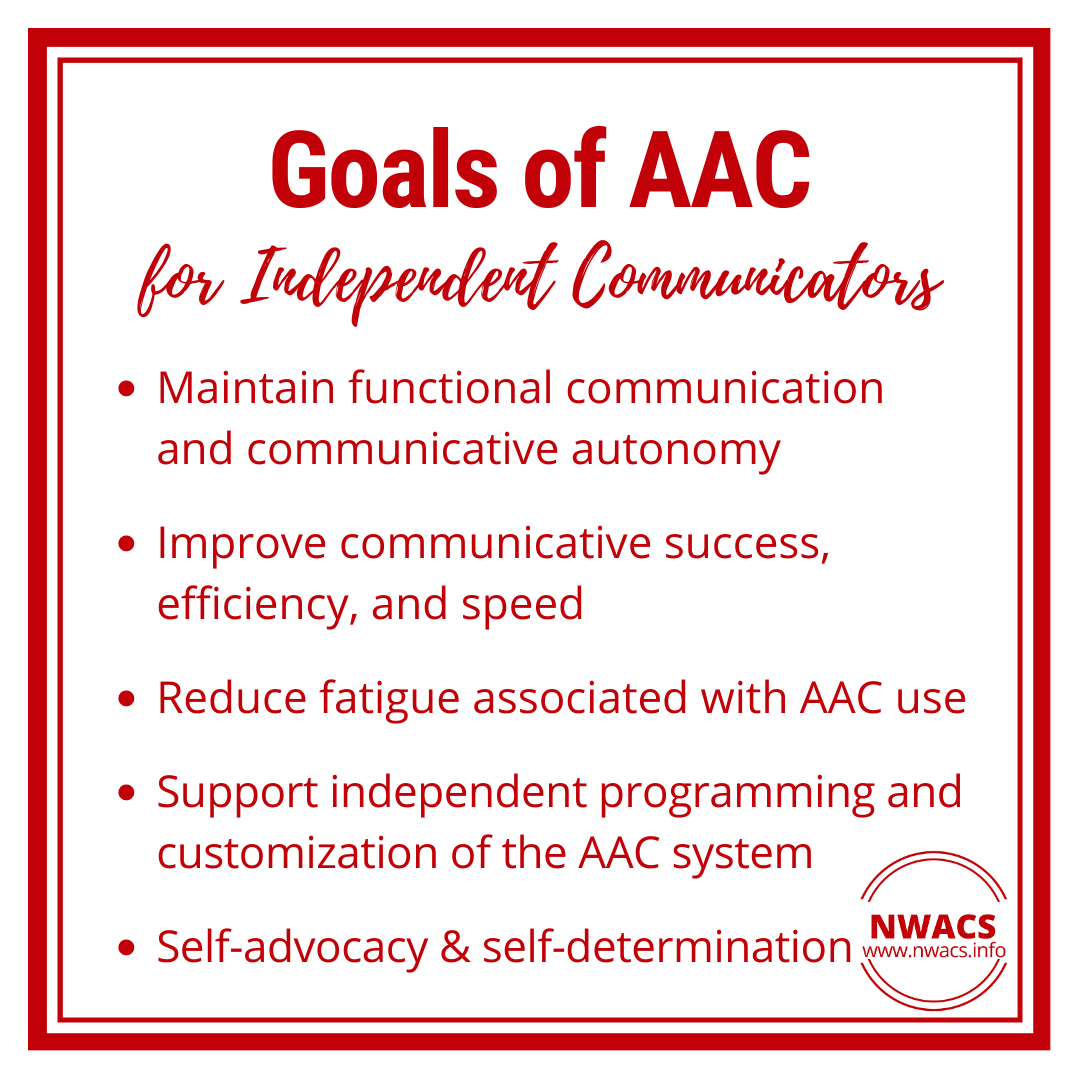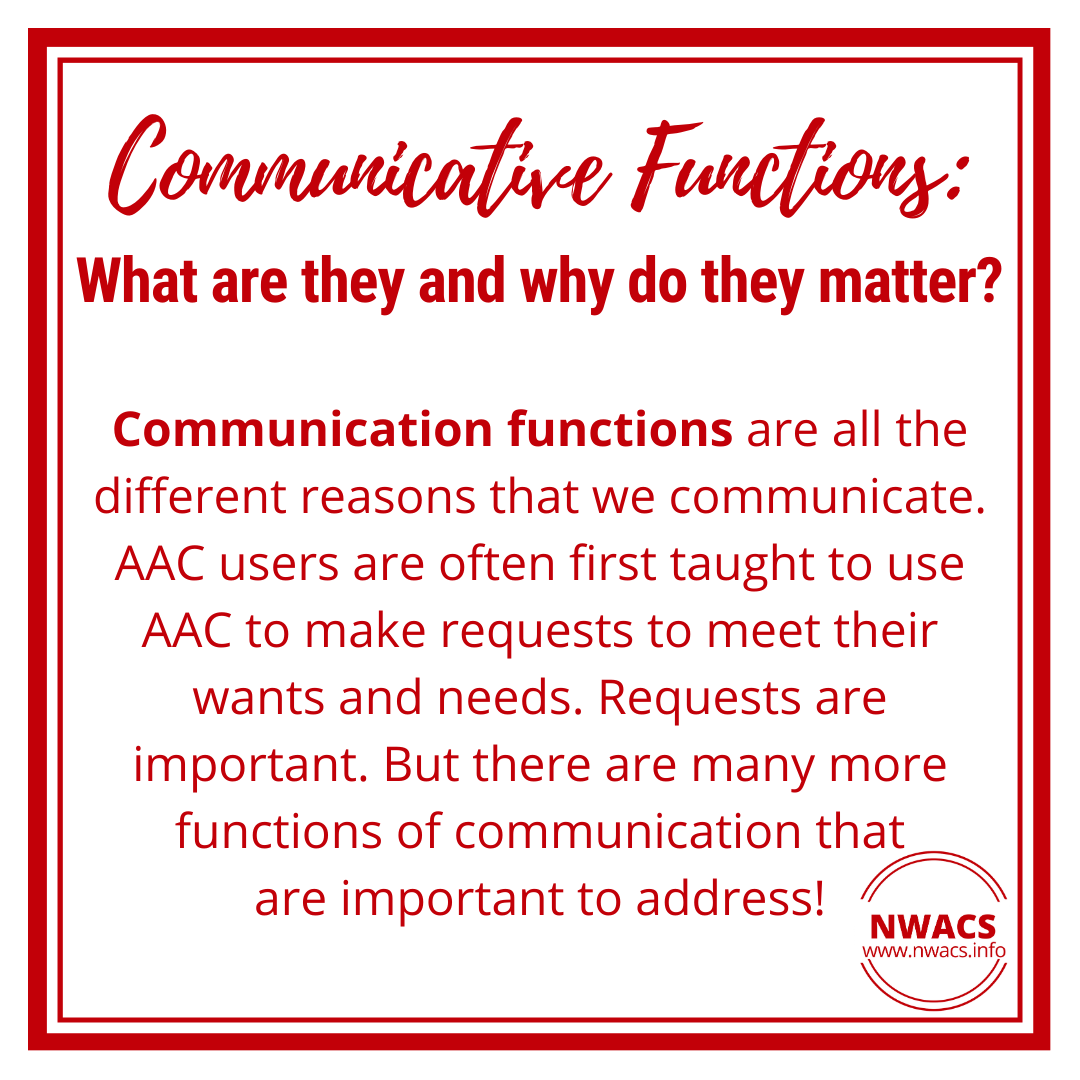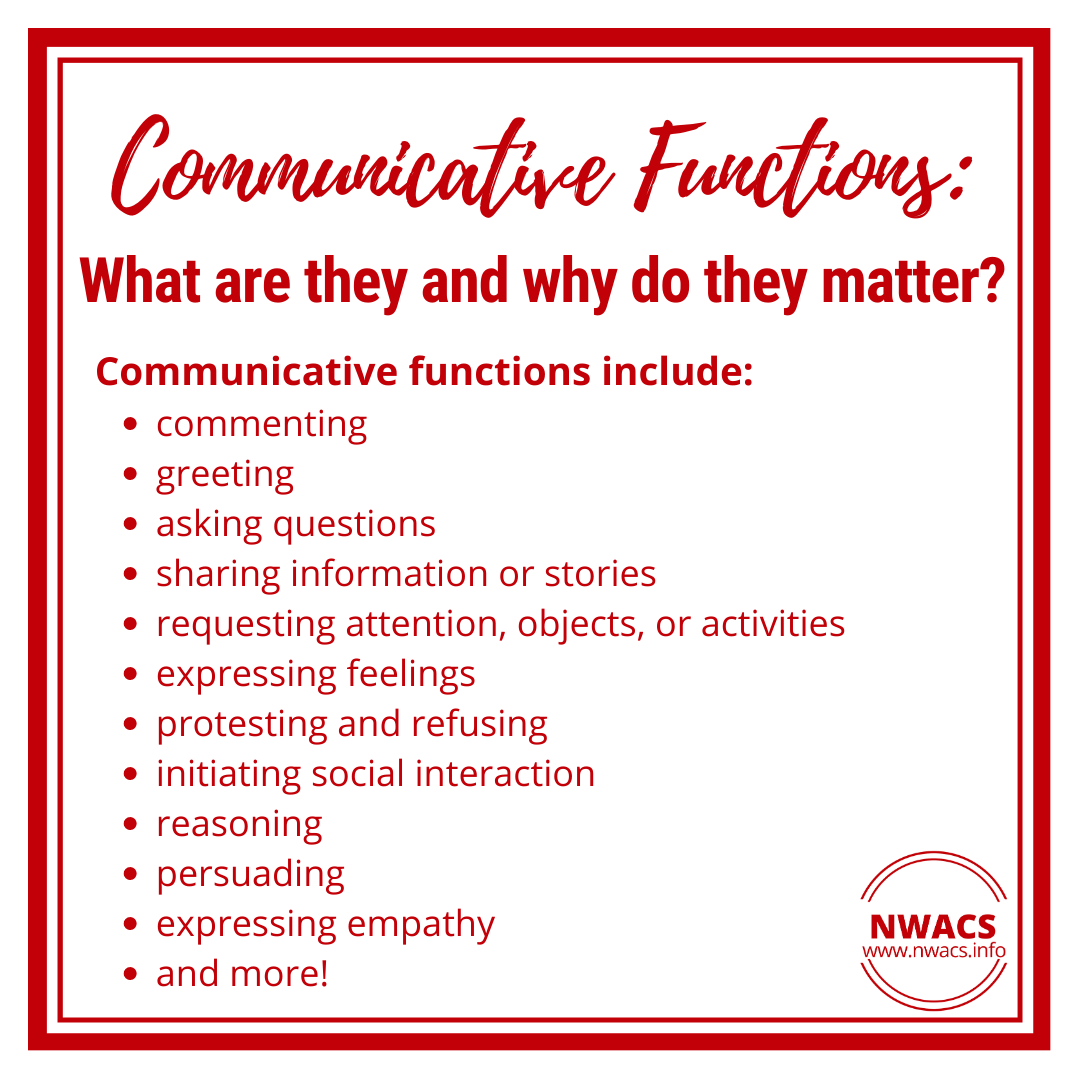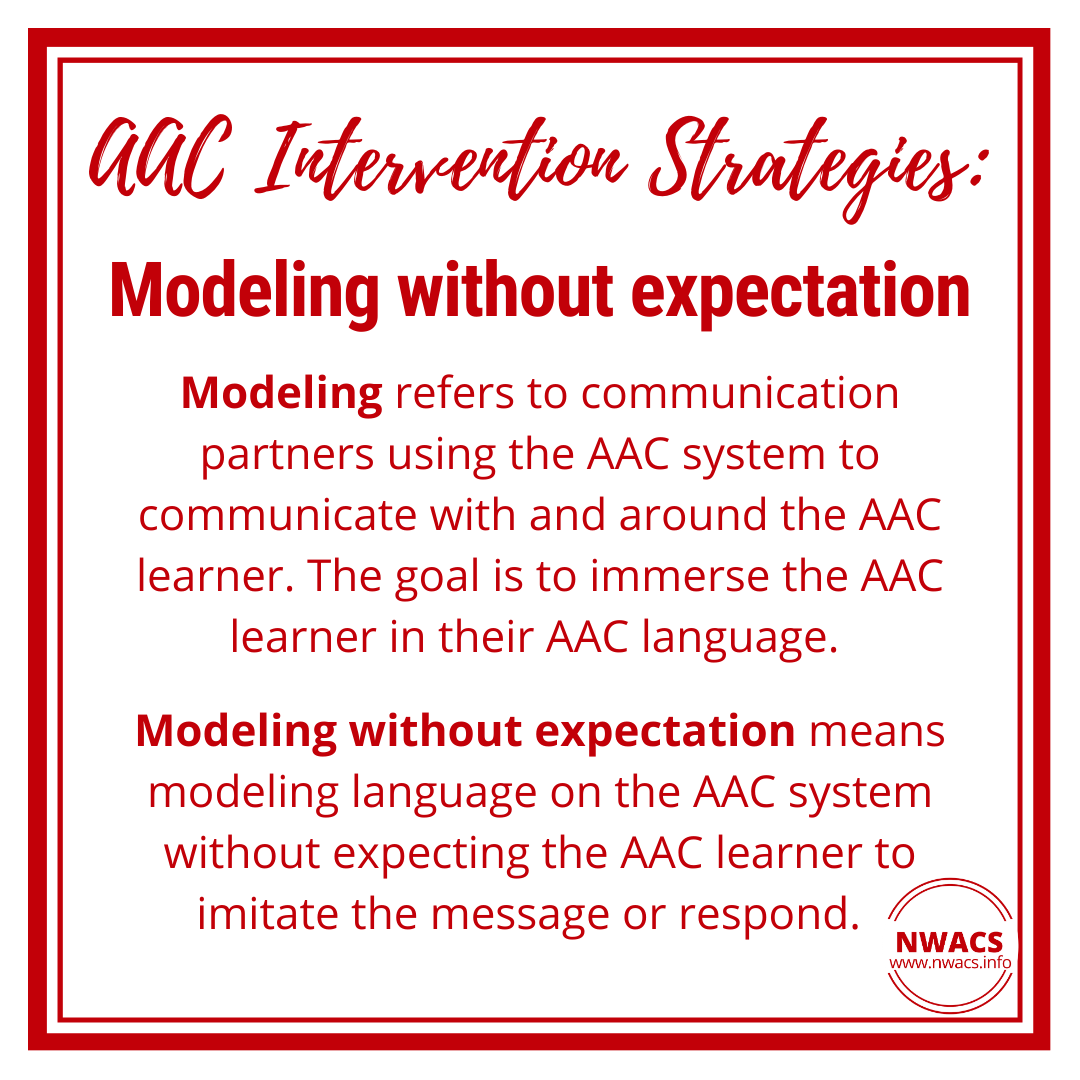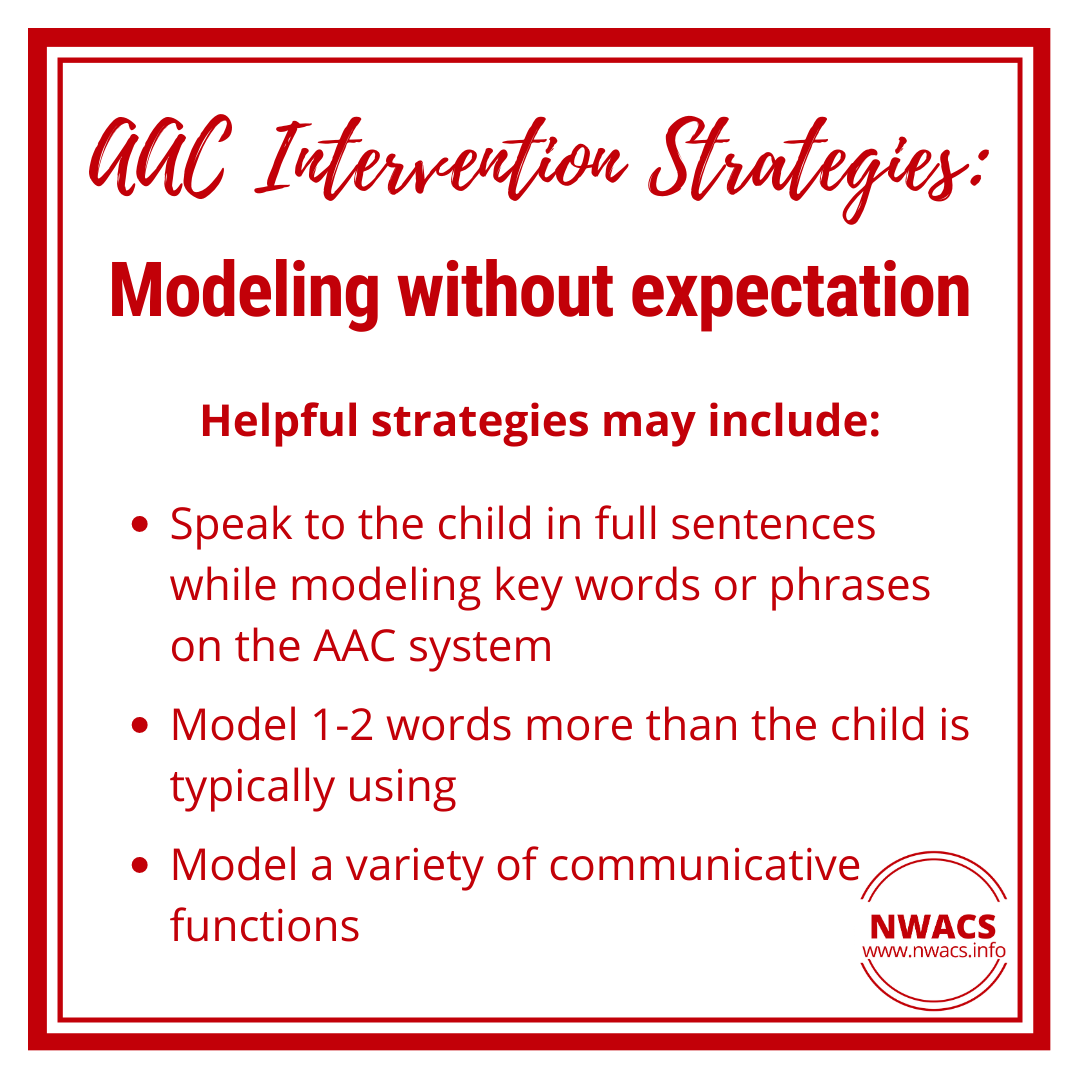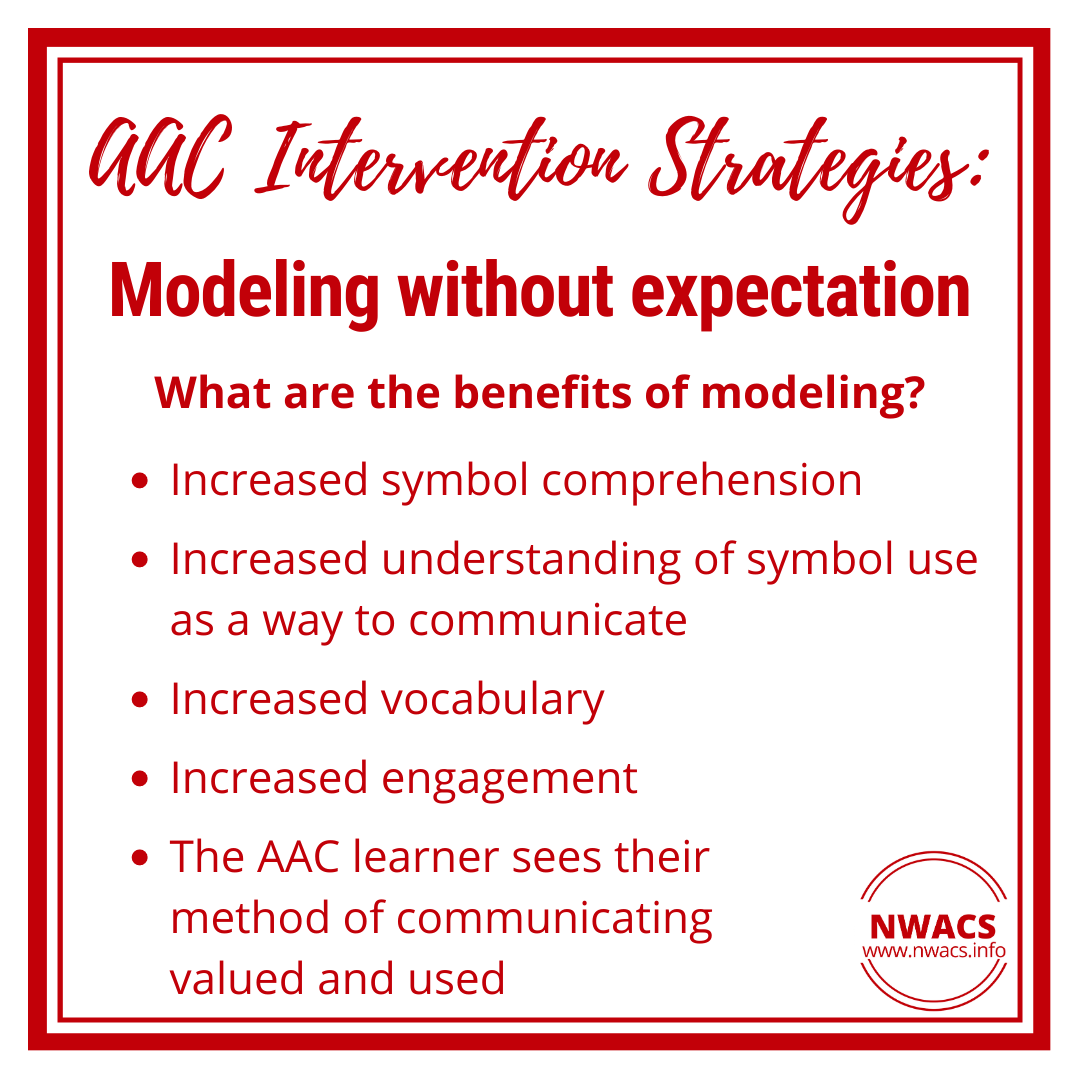AAC in Preschool
This is a curated collection of information and resources related to supporting augmentative and alternative communication (AAC) in children ages three to five years. We encourage you to explore and judge for yourself which to add to your toolbox.
These resources are for educational purposes. This is not an exhaustive list. Inclusion does not signify endorsement. Use of any information provided on this website is at your own risk, for which NWACS shall not be held liable.
Do you have a favorite resource or strategy that we missed? Send us an email to share!
What does supporting communication development look like at this age?
FUN! It looks like having fun!
The work of children is play. Play is not frivolous. Play is brain building. Play is powerful! Children learn best through play and exploration. So many skills can be learned and developed through play - including communication!
Child-led and play-based! It looks like following the child’s lead.
When working with young children, we follow their ideas and interests. We build upon and within what they are doing and are focused on. We adapt to their preferred items, activities, and interests. We can talk about what they are doing. We can model language within whatever they are drawn to. We can target core words during play.
We can
comment
describe
ask and answer questions
share opinions
refuse, reject, disagree
make a plan
negotiate
take conversation turns
“Scientists have recently determined that it takes approximately 400 repetitions to create a new synapse in the brain – unless it is done with play, in which case, it takes between 10 and 20 repetitions!”
And more! Most importantly, we can play with them and reinforce connections that are happening. We can show them the joy of connecting and communicating with another person!
Emergent literacy! It looks like supporting emergent literacy skills.
Language and literacy develop in tandem - language development supports literacy development, and literacy development supports language development. So supporting communication development looks like lots of shared reading. It looks like developing concepts of print. It looks like playing with sounds, letters, and words. It looks like developing letter-sound correspondence. It looks like shared writing. And it still looks fun!
We want young children interested in people and motivated to interact. We want them willing to take the risk and make the effort to engage and communicate.
Key Goals
support language and communication development
continue using language development as a guide
vocabulary development
verbs (action words)
describing words
pronouns/people’s names
“power words” / words to self-advocate
morphological development
grammar development
moving from words to sentences to short narratives
answering questions
social connection and engagement
communication partner training and education
early literacy development
listening comprehension
alphabet knowledge
phonological/phonemic awareness
print knowledge/concepts of print
emergent writing
“AAC represents a developmental pathway to communication and language competence. ”
What AAC Looks Like
multimodal (also see this blog post for more information about multimodal communication)
environmental supports for communication
able to grow with the child
matches access and other features needed by the child
Helpful Implementation Strategies
communication partner training and support
modeling without expectation
model 1-2 words more than the child is typically using
model language for a variety of communicative functions
create communication and learning opportunities through experiences
embed AAC in daily routines (motivating, repetitive, predictable)
partner-assisted/co-constructing messages
expectant pause
language expansion and extension
identify, reason and talk about, and respond to emotions
explicitly teach concepts and word meanings
“HOW I expressively communicate may be different, but not WHAT I needed to develop linguistically in order to communicate. ”
Resources to Explore
Articles, Books, and Documents
AAC Implementation in Inclusive Early Childhood Settings Communication Matrix Collection by Amy Starble (2017)
Augmentative and Alternative Communication: Challenges and Solutions (2021), Billy Ogletree
Chapter 3: AAC in Preschool: Navigating Challenges in Language and Literacy Instruction by Andrea Barton-Hulsey, Marika King, and Jennifer Lyons-Golden
Comprehensive Literacy for All: Teaching Students with Significant Disabilities to Read and Write (2020) by Karen A. Erickson and David Koppenhaver
Creating a Learner’s Environment at Home by Melissa Lim (2022) NWACS Blog
Emergent Writing Communication Matrix Collection by Eric Sanders (2017)
Fundamentals of AAC: A Case-Based Approach to Enhancing Communication (2023), Nerissa Hall, Jenifer Juengling-Sudkamp, Michelle L. Gutmann, and Ellen R. Cohn (eds)
Shared Reading Communication Matrix Collection by Melissa Pebly (2018)
Strategies for Talking about Emotions as PartnerS (STEPS) instructional program developed by Na & Wilkinson (2015, 2017)
TELL ME: AAC in the Preschool Classroom (2016) by Carole Zangari and Lori Wise
also check out these related posts on the PrAACtical AAC blog
Learning Modules
AAC Learning Center Moodle resources for learning about augmentative and alternative communication (AAC) by the RERC on AAC and the AAC program at Penn State University
Dynamic Learning Maps Professional Development modules related to communicating for a range of purposed and audiences
explore other module topics including Emergent Writing, Writing with Alternative Pencils, and Predictable Chart Writing
Websites
NWACS website
Early Childhood Resources from UNC Center for Literacy and Disability Studies
Project Core implementation model to provide children with access to a flexible Universal Core vocabulary and evident-based communication instruction
Podcast and Webinar Recordings
AAC in the Cloud presentation recordings:
Pretend Play Power - Integrating Literacy Modalities & Tools by Kelly Fonner & Donna McNear (2023)
Supporting Your Youngest Learners - How Carefully Curated Resources with Adult Facilitation Can Promote Language Development, Play, & Communication by Beth Poss (2020)
You’ve Got This! Caregivers as the Driving Force in Early AAC Implementation by Kate Ahern (2019)
Language Development & AAC: Back to Basics podcast from SLP Nerdcast with guests Dr. Cathy Binger and Dr. Jennifer Kent-Walsh (2021)
The impact of early access to AAC webcast by Dana Nieder at the RERC on AAC State of the Science Conference (2018)
Nieder, D. (2018, July 13). The impact of early access to AAC. Retrieved from https://aac-learning-center.psu.edu/2018/07/19/the-impact-of-early-access-to-aac-dana-nieder/
Other Resources
Road Maps (Patricia Dowden, Ph.D., CCC-SLP, University of Washington; shared with permission at 2017 WSLHA Spring Workshop)
Useful Tips
Families/caregivers of and professionals working with young children need to be told about the option and benefits of AAC!
Families/caregivers of and multidisciplinary professionals working with young children need training and ongoing support!
Stay family-centered and child-centered!
pay attention to the pace that works best for the family
Focus on communicative intent, not how the message was communicated.
“The success (or failure) of the intervention will depend on the fit with the entire family system, not just the individual who requires AAC. The only way to ensure this contextual fit is to listen to families in order to understand their priorities and concerns. ”
Learn about prompting hierarchies, different kinds of prompts/cues, and how to fade them.
Being proactive and starting AAC early is research-supported!
Research indicates that various types of AAC systems can be effective with children 0-6 years across a wide variety of disabilities (including high-tech, robust systems)!
Presume competence! Presume Potential! Believe they CAN learn!
Find your support networks!
Families:
Leslie Jeanne Berns Support Group for children who have communication challenges and their families (facilitated by University of Washington Speech and Hearing Sciences clinical faculty (SLP) and graduate students; meets virtually, monthly)
Northwest Augmentative Communication Caregiver Society (NWACCS) - This Facebook group (administrated by NWACS) is for families in Washington State. It is for parents/guardians, family members, and caregivers of children who are unable to meet all their communication needs with spoken language.
AAC vendors and app developers have pages on various social media channels. Many also have Facebook groups that can be a good place to connect with a support network.
also look for social media accounts and/or Facebook groups related to specific diagnoses
and look for social media accounts of AAC users and/or parents of AAC users
Facebook groups, such as:
Professionals:
NAACHO: Networking for AAC and Hangout - This Facebook group (administrated by NWACS) is for SLPs in Washington State who support people who use AAC. It is for collaboration, networking, and supporting each other in the grand adventure of augmentative and alternative communication.
Also be on the lookout for in-person NAACHO events (hosted by NWACS)!
AAC vendors and app developers have pages on various social media channels. Many also have Facebook groups that can be a good place to connect with a support network.
also look for social media accounts and/or Facebook groups related to specific diagnoses
and look for social media accounts of AAC users
Facebook groups, such as:
Selected References:
Binger, Cathy & Light, Janice. (2007). The effect of aided AAC modeling on the expression of multi-symbol messages by preschoolers who use AAC. Augmentative and alternative communication (Baltimore, Md. : 1985). 23. 30-43. DOI: 10.1080/07434610600807470
Fallon, Karen & Light, Janice & Paige, Tara. (2001). Enhancing Vocabulary Selection for Preschoolers Who Require Augmentative and Alternative Communication (AAC). American Journal of Speech-Language Pathology. 10. 10.1044/1058-0360(2001/010)
Lieberman-Betz, R. G., Brown, J. A., Wiegand, S. D., Vail, C. O., Fiss, A. L., & Laura J. Carpenter, L. J. (2023). Building Collaborative Capacity in Early Intervention Preservice Providers Through Interprofessional Education. Language, Speech, and Hearing Services in Schools. https://doi.org/10.1044/2022_LSHSS-22-00110
Neal, C. & Brady, N. (2022). Narrative Interventions for Children Who Use Augmentative and Alternative Communication: A Call and Plan for Future Research. Perspectives of the ASHA Special Interest Groups, 7(6), 1619-1629. https://doi.org/10.1044/2022_PERSP-22-00007
Pope, L., Light, J., & Franklin, A. (2022). Black Children With Developmental Disabilities Receive Less Augmentative and Alternative Communication Intervention Than Their White Peers: Preliminary Evidence of Racial Disparities From a Secondary Data Analysis. American Journal of Speech-Language Pathology. https://doi.org/10.1044/2022_AJSLP-22-00079
Romski, M., Sevcik, R., Adamson, L., Cheslock, M., Smith, A., Barker, R. M., & Bakerman, R. (2010). Randomized Comparison of Augmented and Nonaugmented Language Interventions for Toddlers With Developmental Delays and Their Parents. Journal of Speech, Language, and Hearing Research. https://doi.org/10.1044/1092-4388(2009/08-0156)
Sun, T., Bowles, R. P., Gerde, H. K., & Douglas, S. N. (2022). Supporting AAC Use for Preschoolers With Complex Communication Needs. Young Exceptional Children, 25(2), 101–112. https://doi.org/10.1177/1096250620959664
Timpe, E., Kent-Walsh, J., Binger, C., Hahs-Vaughn, D., Harrington, N., & Schwartz, J. (2021). Using the ImPAACT Program with preschoolers with Down syndrome: A hybrid service delivery model. Augmentative and Alternative Communication, 37, 113-128. 10.1080/07434618.2021.1921025







